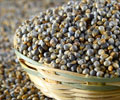A new study reveals that development of new technologies and ingredients are responsible for the improving taste, appearance and nutritional content of gluten-free food products.

A growing number of consumers with celiac disease, those with a "sensitivity" to gluten, and/or those with preference for gluten-free foods are driving the demand for these products, said Chris Thomas, senior food technologist at Ingredion, Inc.
"Historically, product development has focused on the 'gluten-free' aspects,'" said Thomas. "Now, consumers want nutrition quality, variety and appearance."
Because of manufacturing and ingredient challenges, gluten-free products often have a gritty or dry texture and a short shelf life. To mask or enhance a bland taste, some have high amounts of sugar and little nutritional value. Fortunately, innovative manufacturing technologies are improving the texture of gluten-free products and the development and use of flours, starches and bran made from alternative ingredients, are enhancing taste and appearance.
Utilizing "native functional flours based on tapioca and rice, we're able to achieve texture, color and appearance that is similar to wheat-containing products while eliminating grittiness and crumbliness," said Thomas. In addition, these products are similar to wheat-products in calories, fat content, overall nutrition and shelf life.
Pulses -- the edible seeds of leguminous crops -- also are being used to create flour and starch-like substances in gluten-free products, said Mehmet Tulbek, Ph.D, the global director of the research, development and innovation division of Alliance Grain Traders (AGT). These ingredients, made from peas, lentils, chickpeas and edible beans, have a high viscosity, as well as high levels of protein, fiber and other nutrients. They're also low-fat and attractive to vegetarian consumers.
Advertisement
"Pulse ingredients were found to be suitable for gluten-free expanded snack, pasta, meat and beverage products," said Tulbek. "Overall, the ingredients are working very well."
Advertisement
Source-Eurekalert













